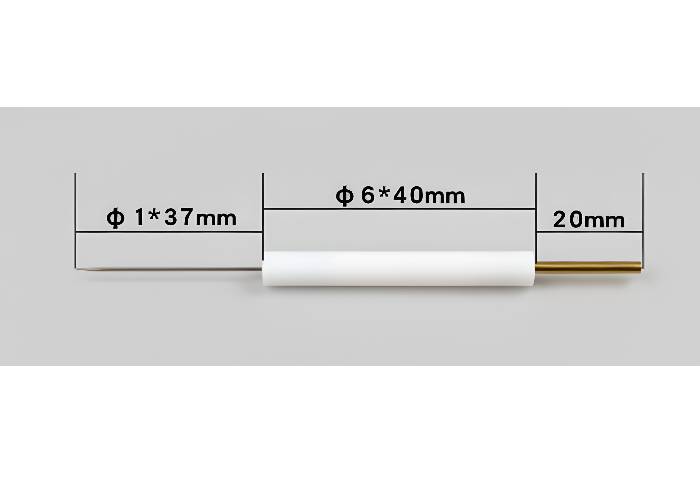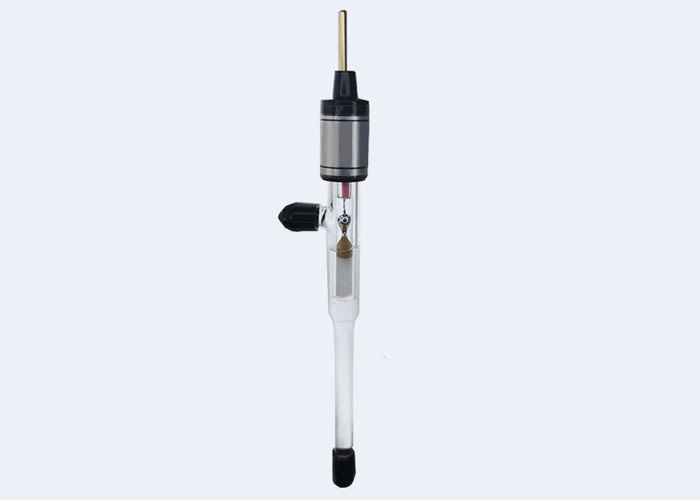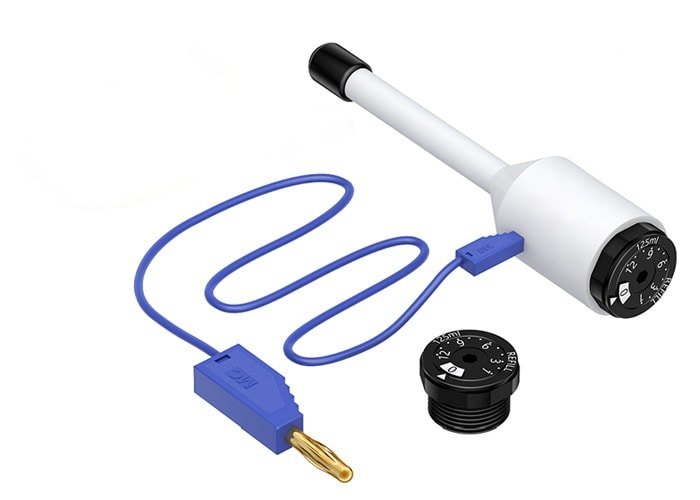Reference Electrodes
Accurate electrochemical measurements demand a stable reference potential against which the working electrode’s potential is gauged, and while the Standard Hydrogen Electrode (SHE) establishes the universal zero, practical research and industrial setups typically employ alternative reference electrodes tailored to specific media and applications. For acidic environments—especially chloride‐rich systems the Hg/Hg₂SO₄ electrode offers robust stability; in alkaline solutions, the Hg/HgO electrode provides a reliable constant potential; when probing non‐aqueous or organic electrolytes, the Ag/Ag⁺ reference electrode ensures compatibility and minimal junction disturbance; the double salt bridge saturated calomel electrode (SCE) combines broad aqueous applicability with ultra‐low junction potentials; and for pH‐adaptive measurements and hydrogen‐evolution studies, the reversible hydrogen electrode (RHE) delivers a zero‐shift potential across the entire pH range. Understanding the distinct mechanisms, advantages, and maintenance considerations of these five reference electrode types empowers researchers to select the optimal system for their electrochemical investigations.
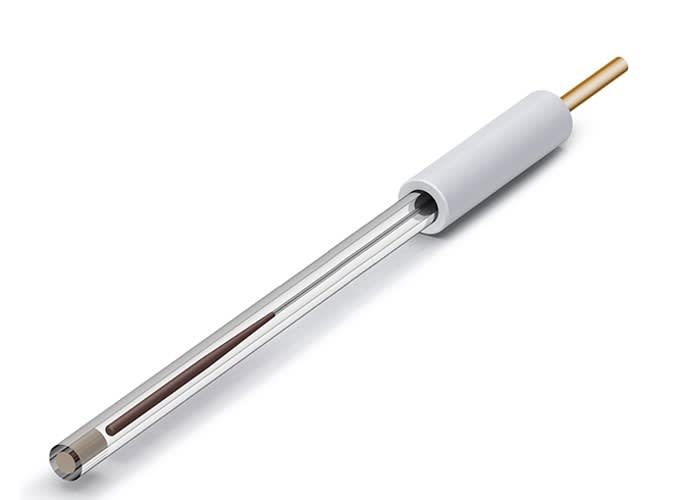
Ag/AgCl Reference Electrode
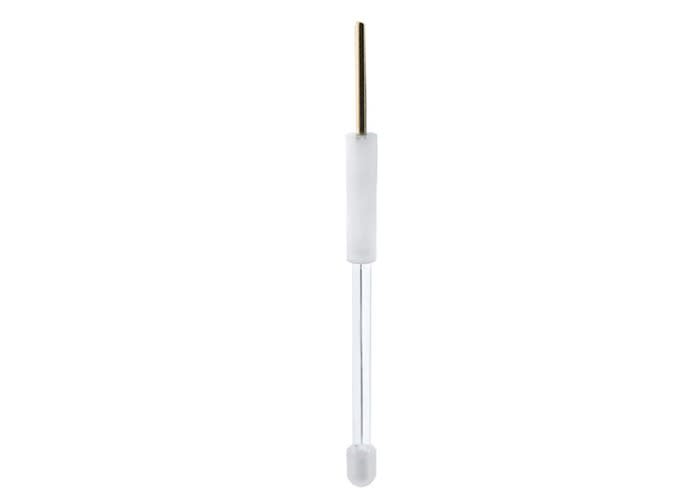
Non-aqueous Ag/Ag+ Reference Electrode

Saturated Calomel Electrode

Double Salt Bridge Saturated Calomel Electrode

Hg/Hg2SO4 Reference Electrode
Introduction to Reference Electrodes
A reference electrode provides a stable, reproducible potential independent of the composition of the test solution. It completes the electrochemical cell circuit and allows precise measurement of the working electrode’s potential. An ideal reference electrode exhibits:
- High chemical stability
- Low junction potential
- Minimal drift
- Compatibility with a wide range of electrolytes
These characteristics ensure reliable potential control in applications from battery research and corrosion studies to sensor calibration and fundamental electrochemical investigations.
Key Performance Criteria
Before diving into individual electrode types, it is essential to understand the attributes that dictate performance:
- Reference Potential Stability: Ability to maintain constant potential over time.
- Liquid Junction Potential: Voltage difference at the interface between reference filling solution and test solution; should be minimized.
- Chemical Compatibility: Resistance to poisoning or degradation by analytes and solvents.
- Temperature Dependence: Potential shift per degree Celsius; low sensitivity is preferred.
- Ease of Use and Maintenance: User-friendliness, refill frequency, and lifetime.
With these criteria in mind, let us explore each reference electrode type in detail.
Hg/Hg₂SO₄ Reference Electrode
The Mercury/Mercury Sulfate (Hg/Hg₂SO₄) reference electrode consists of a mercury droplet in contact with a saturated solution of mercury sulfate (Hg₂SO₄) in sulfuric acid. A porous frit or ceramic junction separates this internal solution from the external test medium.
Electrode Reaction:
Hg2SO4(s)+2 e−⟷2 Hg(l)+SO42−
Hg2SO4(s)+2e−⟷2Hg(l)+SO42−
This half-reaction establishes a stable potential at approximately +0.615 V vs. SHE at 25 °C.
Advantages
- Chemical Robustness: Resistant to chloride poisoning, making it suitable for chloride-containing electrolytes.
- Low Drift: Delivers stable potential over extended measurements.
- Moderate Junction Potential: Porous junctions yield low liquid junction potentials.
Limitations
- Toxicity: Contains mercury; requires careful handling and disposal.
- Acidic Medium: Restricted to non-basic solutions; unsuitable for strongly alkaline environments.
- Temperature Sensitivity: Potential shifts slightly with temperature (–0.8 mV/°C).
Best Applications
- Corrosion testing in chloride-rich media
- Acidic electroplating and electrodeposition studies
- Fundamental electrochemistry where mercury handling is acceptable
Hg/HgO Reference Electrode
The Mercury/Mercury Oxide (Hg/HgO) reference electrode comprises mercury in contact with a paste of mercury oxide (HgO) and a strong alkaline solution (commonly 1 M KOH). A ceramic frit allows ionic communication with the test solution.
Electrode Reaction:
HgO(s)+H2O+2 e−⟷Hg(l)+2 OH−
HgO(s)+H2O+2e−⟷Hg(l)+2OH−
This produces a stable potential of approximately +0.098 V vs. SHE at 25 °C.
Advantages
- Alkaline Compatibility: Ideal for high-pH systems such as alkaline fuel cells and battery electrolytes.
- Long-Term Stability: Minimal drift even in harsh alkaline conditions.
- Moderate Junction Potential: Well-designed frits yield low junction potentials.
Limitations
- Mercury Use: Involves mercury, with associated toxicity concerns.
- Limited to Alkaline Solutions: Not suitable for acidic or neutral electrolytes.
- Light Sensitivity: Mercury oxide can degrade under strong light exposure, requiring opaque housings.
Best Applications
- Alkaline battery R&D (Ni–Cd, Ni–MH)
- Fuel cell performance studies
- Electrochemical analysis in basic media
Non-Aqueous Ag/Ag Reference Electrode
The Non-Aqueous Silver/Silver Ion (Ag/Ag ) reference electrode is tailored for organic solvents (acetonitrile, propylene carbonate, etc.), incompatible with aqueous references. It features a silver wire immersed in a solution of Ag⁺ salt (e.g., AgNO₃) and supporting electrolyte in the organic solvent.
Electrode Reaction:
Ag++e−⟷Ag(s)
Ag++e−⟷Ag(s)
Potential is solvent- and electrolyte-dependent but typically sits around +0.10 V vs. ferrocene/ferrocenium in acetonitrile.
Advantages
- Non-Aqueous Compatibility: Directly immersible in organic electrolytes.
- Minimal Liquid Junction: Often uses a glass frit or double junction to reduce junction potentials.
- Versatility: Easily customized with different Ag⁺ concentrations and salts.
Limitations
- Potential Variability: Depends heavily on solvent and supporting electrolyte; calibration against internal standards (ferrocene) is recommended.
- Junction Complexity: Double salt bridges may be needed to isolate water traces from the test medium.
- Lower Stability: Slight drift if moisture ingress occurs.
Best Applications
- Lithium-ion battery electrode studies
- Organic electrosynthesis and redox kinetics
- Non-aqueous electrochemical sensor development
Saturated Calomel Electrode (SCE)
The SCE consists of a pool of elemental mercury in contact with a paste of mercurous chloride (calomel, Hg2Cl2) saturated with potassium chloride (KCl). The half-cell reaction is:
Hg2Cl2(s)+2 e− ⇌ 2 Hg(l)+2 Cl−
Hg2Cl2(s)+2e−⇌2Hg(l)+2Cl−
Under standard conditions with saturated KCl, the SCE exhibits a potential of +0.244 V relative to SHE.
Design Variations
- Single-Junction SCE: Calomel paste and saturated KCl are layered under a solution of saturated KCl. Contact with the sample is via a porous glass frit, which provides ionic conduction.
- Double-Junction SCE: Incorporates an intermediate salt bridge solution between the reference half-cell and the sample. This reduces the risk of contaminating sensitive analytes (e.g., halide ions) by leakage from the saturated KCl solution, at the cost of introducing a second junction potential.
Advantages
- Excellent potential stability over time and temperature fluctuations.
- Robustness against electrolyte evaporation; the saturated nature of the KCl ensures constant ionic activity as long as solid KCl crystals remain.
- Widely available commercial designs, often integrated into combination electrodes.
Limitations
- Contains mercury, posing environmental and health hazards.
- Potential contamination of the sample solution by KCl leakage, impacting measurements of halide-sensitive analytes.
- Requires proper disposal considerations under hazardous waste regulations.
Best Practices for Use and Maintenance
- Inspect the porous frit regularly for clogging or salt crystal buildup; clean with dilute KCl solution as needed.
- Replenish KCl saturation by adding solid KCl to the reservoir when crystals are depleted.
- Store the electrode immersed in a saturated KCl solution to maintain paste hydration and crystal equilibrium.
- Rinse the junction with distilled water before and after measurements to minimize cross-contamination.
Silver/Silver Chloride Electrode (Ag AgCl reference electrode )
The Ag AgCl reference electrode employs a silver wire coated with a layer of silver chloride, immersed in a solution saturated with both potassium chloride and silver chloride. The half-cell reaction in the presence of excess chloride ions is:
AgCl(s)+e− ⇌ Ag(s)+Cl−
AgCl(s)+e−⇌Ag(s)+Cl−
The theoretical potential of this half-cell is +0.222 V vs. SHE. In practical saturated KCl environments, the potential is +0.197 V vs. SHE, reflecting the actual chloride ion activity achieved.
Design and Junction Configurations
- Single-Junction Ag/AgCl: Silver wire within saturated KCl solution. Ionic contact via a porous junction permits interfacing with the sample.
- Double-Junction Ag/AgCl: Similar to SCE, uses an intermediate salt bridge to isolate the reference electrolyte from the sample, minimizing contamination at the expense of additional junction potential.
Advantages
- Free of mercury, making it environmentally safer and more widely accepted.
- Simpler construction compared to SCE and lower toxicity.
- Stable, reproducible potentials over extended use.
- Good compatibility with chloride-containing samples.
Limitations
- Potential sensitive to chloride ion activity: high ionic strength or mixed salts can shift the electrode potential if chloride activity deviates from nominal saturation.
- Junction leakage can introduce chloride ions into samples, problematic for chloride‐sensitive analyses.
Best Practices for Use and Maintenance
- Periodically polish the silver wire to remove passivation and ensure tight Ag/AgCl interface.
- Maintain solid AgCl crystals in the reservoir to ensure saturated chloride activity.
- Store the electrode in saturated KCl solution when not in use.
- Avoid exposure to light, which can photochemically reduce AgCl over time, altering potential.
Reversible Hydrogen Electrode
The Reversible Hydrogen Electrode (RHE) consists of a platinum or platinized platinum surface in contact with hydrogen gas at 1 atm and the test solution. Unlike the SHE, the RHE’s potential automatically adjusts with solution pH, making it especially convenient.
Electrode Reaction:
2 H++2 e−⟷H2(g)
2H++2e−⟷H2(g)
Potential is defined as 0 V vs. RHE at all pH values, shifting by –59 mV per pH unit relative to SHE.
Advantages
- pH Dependence: Directly tied to proton activity; no junction potential issues.
- No Filling Solution: Simplified construction and maintenance.
- Universal: Works seamlessly across acidic to alkaline pH ranges.
Limitations
- Gas Handling: Requires hydrogen gas supply and leaks must be avoided.
- Surface Contamination: Platinum catalyst can foul, altering overpotential.
- Pressure Sensitivity: Must maintain 1 atm H₂ to ensure stable potential.
Best Applications
- Water-splitting and hydrogen evolution reaction (HER) studies
- pH-dependent kinetics of electrocatalysts
- Fuel cell catalyst benchmarking
Comparative Analysis of Reference Electrode Types
Key Takeaway: The choice of reference electrode depends on the required potential stability, working pH range, medium compatibility, and maintenance considerations.
| Electrode Type | Reference Potential | Medium | Mercury Content | Liquid Junction Potential | Operating pH Range | Maintenance | Key Application |
|---|---|---|---|---|---|---|---|
| Hg/Hg₂SO₄ (0.5 M H₂SO₄) | +0.615 V vs. SHE | Acidic sulfate | Yes | Low | < 2 | Moderate | Corrosion; acid electroplating |
| Hg/HgO (1 M NaOH) | +0.098 V vs. SHE | Alkaline | Yes | Low | > 9 | Moderate | Alkaline batteries; fuel cells |
| Non-Aqueous Ag/Ag⁺ (0.1 M AgNO₃ in ACN) | ≈ +0.10 V vs. Fc/Fc⁺ | Organic solvents | No | Moderate | N/A | High | Li-ion batteries; electrosynthesis |
| Double-Bridge SCE (sat. KCl) | +0.244 V vs. SHE | Aqueous chloride | Yes | Very low | 2–12 | Moderate | pH calibration; EIS |
| RHE | 0 V vs. RHE | Aqueous (all pH) | No | None | 0–14 | High | HER kinetics; fuel cells |
| Ag/AgCl (sat. KCl) | +0.197 V vs. SHE | Aqueous chloride | No | Low | 0–14 | Low | pH calibration; general potentiometry |
Best Practices in Handling and Maintenance
- Mercury Electrode Safety: Always wear gloves, work under a fume hood, and follow local disposal regulations.
- Temperature Control: Use thermostatted baths or compensation calculations to correct potential shifts.
- Junction Care: Keep frits clean to avoid clogging; replace salt bridges periodically.
- Gas Purity: For RHE, use high-purity H₂ and proper gas-tight fittings.
- Calibration: Regularly calibrate non-aqueous Ag/Ag⁺ electrodes against an internal standard such as ferrocene.
Conclusions and Recommendations
Selecting the appropriate reference electrode hinges on electrolyte compatibility, potential stability requirements, and practical considerations such as maintenance complexity and safety. For acidic systems, the Hg/Hg₂SO₄ electrode offers robust performance in chloride-rich media. In alkaline environments, the Hg/HgO electrode excels. When working in organic solvents, a customized non-aqueous Ag/Ag⁺ reference electrode is essential. The double salt bridge SCE remains a workhorse for aqueous potentiometric measurements needing ultra-low junction potentials. Finally, the RHE is unmatched for hydrogen evolution and pH-dependent studies, provided gas handling is feasible.
By carefully matching electrode characteristics to your experimental conditions, you can achieve reliable, drift-free potential control and elevate the quality of your electrochemical research. Choose wisely, maintain routinely, and your reference electrode will enable precision measurements across a broad spectrum of applications.
Frequently Asked Questions on Reference Electrodes
1. What is the role of a reference electrode in electrochemical measurements?
A reference electrode provides a stable and reproducible potential against which the working electrode’s potential is measured. By maintaining a constant internal environment, it ensures that fluctuations in the test solution do not affect the reference potential, enabling accurate control of electrode potentials in applications such as battery testing, corrosion analysis, and sensor calibration.
2. How do liquid junction potentials affect reference electrode performance, and how can they be minimized?
Liquid junction potentials arise at the interface between the filling solution and the sample electrolyte, causing measurement error. To minimize this effect, use double salt bridges, porous ceramic frits with optimized pore size, and ensure the filling solution’s ionic strength closely matches that of the test medium. Regular maintenance—such as replacing clogged frits and refreshing bridge salts—also keeps junction potentials low.
3. Why choose a Hg/Hg₂SO₄ reference electrode for chloride‐rich acidic solutions?
The Hg/Hg₂SO₄ electrode features a mercury sulfate-based internal solution that resists chloride poisoning better than calomel electrodes. This resistance maintains long-term stability and low potential drift in acidic, chloride-containing electrolytes, making it ideal for corrosion studies and electrodeposition processes where chloride ions are prevalent.
4. In what scenarios is the Hg/HgO reference electrode preferred, and what are its main maintenance requirements?
The Hg/HgO electrode excels in high-pH environments, such as alkaline battery research and fuel cell testing. It operates reliably in strong KOH solutions with minimal drift. Maintenance involves protecting the mercury oxide paste from light exposure, periodically checking KOH concentration, and ensuring the ceramic junction remains unclogged to preserve junction integrity.
5. How does a non‐aqueous Ag/Ag⁺ reference electrode differ from its aqueous counterparts, and what calibration steps are necessary?
A non‐aqueous Ag/Ag⁺ electrode uses organic solvents (e.g., acetonitrile) and silver ion salts, making it compatible with lithium-ion battery electrolytes and organic electrosynthesis. Since its potential varies with solvent and salt concentration, calibration against an internal redox standard like ferrocene/ferrocenium is essential before each experiment to ensure accurate potential referencing.
6. What advantages does a double salt bridge SCE offer for mixed aqueous–organic media?
The double salt bridge saturated calomel electrode (SCE) includes an intermediate salt solution that isolates the internal KCl filling solution from the sample. This design dramatically reduces junction potentials when working in low-ionic-strength or mixed solvent systems, providing stable potentials without contamination or solvent incompatibility.
7. How does the reversible hydrogen electrode (RHE) adjust its potential across different pH values, and what are its operational constraints?
The Reversible Hydrogen Electrode (RHE) maintains 0 V by equilibrating hydrogen gas at 1 atm with the test solution’s proton activity. Its potential shifts by –59 mV per pH unit relative to SHE, automatically compensating for pH. Operational constraints include the need for high-purity H₂ gas, robust gas-tight fittings, and regular cleaning of the platinum surface to prevent catalyst poisoning.
8. What safety and handling precautions should be followed with mercury‐based reference electrodes?
When using mercury-containing electrodes (Hg/Hg₂SO₄, Hg/HgO, SCE), always wear chemical-resistant gloves and goggles, work in a well-ventilated fume hood, and follow local hazardous waste regulations for disposal. Avoid direct contact and mercury vapor exposure, and store electrodes in labeled, sealed containers to prevent environmental contamination.
9. How does temperature variation impact reference electrode potentials, and what compensation methods can be used?
Reference electrode potentials shift with temperature due to changes in ion activity and solubility. For example, the Hg/Hg₂SO₄ electrode shifts by approximately –0.8 mV/°C. To compensate, use thermostatted baths to control cell temperature or apply mathematical corrections based on known temperature coefficients, ensuring consistent potential measurements.
10. What criteria should guide the selection of a reference electrode for a new electrochemical application?
Selecting the right reference electrode involves evaluating:
-
Electrolyte compatibility (acidic, alkaline, non-aqueous)
-
Required potential stability and allowable drift
-
Junction potential tolerance
-
Maintenance complexity and safety considerations (e.g., mercury use)
-
Temperature range and pH adaptability
Balancing these factors ensures optimal measurement accuracy and operational efficiency for your specific electrochemical research.
Maintenance and Support
All ScienceGears reference electrodes include comprehensive maintenance documentation and technical support resources. The Reference Electrode FAQ & Maintenance Guide provides detailed protocols for electrode care, storage requirements, and performance optimization.
ScienceGears maintains inventory and technical support throughout Australia and New Zealand, ensuring rapid access to precision electrochemical instrumentation for research institutions and industrial laboratories.

